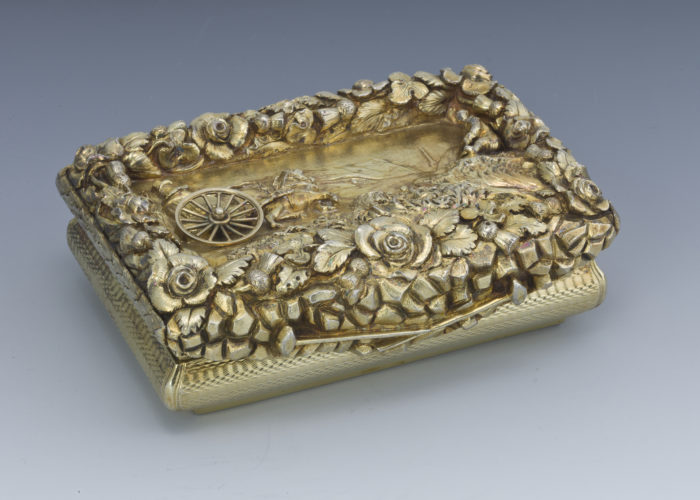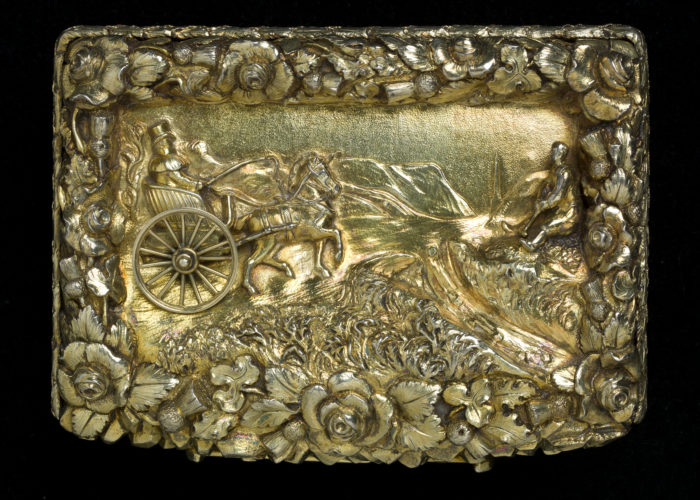John McAdam’s snuff box
Theme: Transporting revolution, The impact of industry, Economic and technological revolution
John McAdam revolutionised road travel in the 1800s, through his ‘Macadamisation’ method. The greatest advance in road construction since Roman times, his principles are still applied to road building today.
John Loudon McAdam (1756-1836) was born in Ayrshire. As a young man he made his fortune selling cargos seized during the American Revolution in New York, and later operating coal and ironworks in Scotland where he was a turnpike trustee, before eventually settling in Bristol in 1802. Here he worked as a surveyor, responsible for 149 miles of road. At this time, roads were uneven and full of potholes and ruts. This made coach, wagon and horse journeys long and uncomfortable, with damage to equipment and freight. Realising the importance of a smooth, compact and lasting road surface, and encouraged by Parliamentary enquiries, he developed his revolutionary new methods.
McAdam’s first idea was to replace the traditional foundations of layers of rock. He saw that the naturally occurring soil would support the traffic, as long as it was protected by a road ‘crust’. He made the base of this crust from large stones. He then layered a mix of crushed stone (hardcore) and gravel on top, which filled the gaps. Crucially, the stones for each layer were carefully broken to a specific size, with stones in the top layer being smallest. These were then compacted by the wheels of the travelling vehicles, forming a naturally smooth road.
His second idea was to give the road a ‘camber’. This meant the road surface was slightly curved, sloping down to its edges. Rainwater would then run off into ditches either side without penetrating and damaging the deeper structures.
McAdam introduced this method to his Bristol roadways. His roads proved hard-wearing and easy to maintain and the method was quickly adopted throughout Europe and the USA. The process became known as ‘macadamisation’ or ‘macadam’. Aside from the addition of a tar mixture (introduced in 1902 by Edgar Hooley) to the macadam, road construction and ‘tarmacking’ remains largely unchanged today.
This silver gilt snuff box was presented to John McAdam by the Body of Commercial Travellers, in appreciation of the improved state of the roads. It was made in Birmingham in 1826, and is decorated with a coach travelling on a newly-macadamised road.
Did you know..?
The labourers who broke up the stones for the top layer of the macadam could test whether or not they had made them small enough by seeing whether they would fit into their mouths.
Use our Classroom resources to investigate this object and the theme of Transport further.
Highlights:
- Using objects, artworks and other sources to find out about the past
- Enquiry: How was transport different in the past?
- Enquiry: A transport revolution?
- Transport pairs
And much more…
Sources & acknowledgements
This object description and its related educational resources were researched and written by our team of historians and education specialists. For further information see the item’s home museum, gallery or archive, listed above.
-
Did you know..?
The labourers who broke up the stones for the top layer of the macadam could test whether or not they had made them small enough by seeing whether they would fit into their mouths.
-
Education overview
You can access a range of teachers resources related to this object and more on our education page.
Please also see our glossary of terms for more detailed explanations of the terms used.
-
Curatorial info
- Originating Museum: National Museums Scotland
- Accession Number: H.1993.56
- Production Date: 1826
- Material: Silver-gilt
- Creation Place: Birmingham, Warwickshire, England
- Original record
-
Use this image
- Rights Holder: © National Museums Scotland
- License Type: All Rights Reserved





